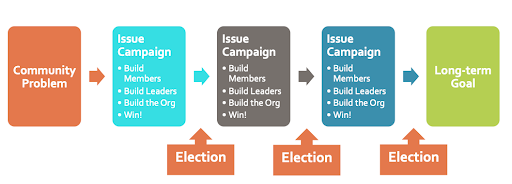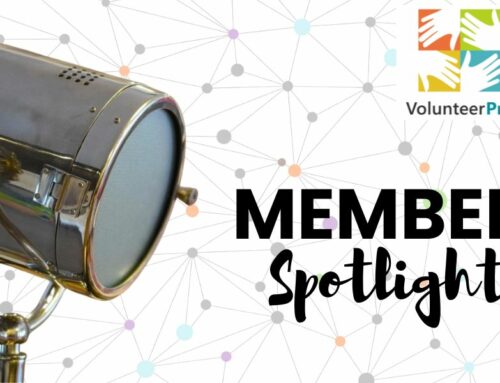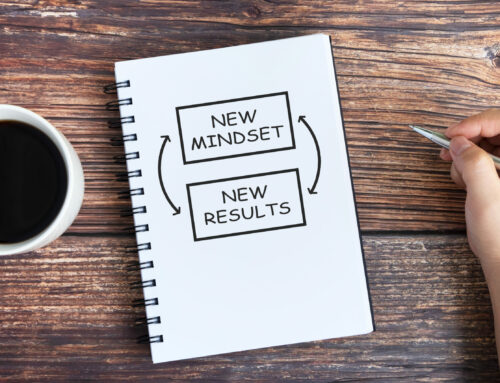
3 Proven Volunteer Program Development Models
There are a few different ways of looking at volunteer program development. Today we will look at three models:
- The Volunteer Lifecycle
- Levels of Volunteer Engagement
- Volunteers as Community Assets
All perspectives may be valid depending on the management decisions you are trying to make, the problems you are attempting to solve, and the kinds of information you hope to gather and report.
Model 1: The Volunteer Lifecycle
The first volunteer program development model comes from a human resources perspective: managing throughout the volunteer lifecycle. Organizations often focus on recruitment, screening, training, and recognition, but all are important for creating an infrastructure where volunteers can be successful.

In addition, in order to have successful volunteer engagement, someone needs to be responsible for each step in the volunteer engagement cycle.
Volunteer engagement won’t just happen on its own.
Questions for Each Stage of the Volunteer Lifecycle
As organizations build or improve their programs, ask these specific questions to maximize volunteer engagement.
Needs Analysis
- What are your organization’s goals?
- Where are the gaps?
- What are the risks of volunteer involvement and how will they be mitigated?
Recruiting
- Who is your target audience?
- Where can you find them?
- Which messages will appeal to them?
- What partnerships can help you connect with them?
Screening
- What are the minimum requirements for volunteers?
- Are there things that are simply nice-to-have but not must-have?
- What are the key motivations of the candidate and what are their needs?
- How and when does the volunteer want to offer their support?
- How can you best reward and recognize them in the future?
Placement
- What specific roles will the volunteer be assigned?
- Who will provide them with day-to-day support?
- What is their scheduled length of commitment?
- When do they start and what do they need to know beforehand?
Orientation/Training
- Who will welcome them to the team?
- How will policy and procedure orientation occur?
- What specific technical and interpersonal skills do they need for their role?
- How will training for their role occur – in the classroom and beyond?
Resourcing/Supervision
- What tasks will the volunteer do?
- What is not included in their scope of work?
- How will work be delegated – by whom and to whom?
- How many minimum hours a month is the volunteer expected to commit?
- Who will directly address problems as they arise?
Recognition
- How will the team leader or supervisor offer support to volunteers?
- How will you acknowledge specific achievements, growth, and key learning?
- In what ways will individual volunteers and teams be recognized and thanked?
- What leadership opportunities will be made available?
Retention
- How will you report program and policy changes to volunteers?
- In what ways will you address volunteer complaints?
- How will you gather volunteer suggestions and feedback?
- How will you directly address why volunteers leave?
Evaluation
- What will ensure the ongoing quality of volunteer work?
- How will you assess and handle program gaps?
- How will you track volunteer satisfaction over time?
- In what ways will you track and report your program goals and achievements?
Culture & Buy In
- How will you promote positive and productive volunteer-staff relations?
- How will you ensure quality program standards and ethical practice are the norm?
- What will ensure the ongoing quality of volunteer supervision and support?
- What change management strategies will you use to navigate inevitable evolutions?
Model 2: Levels of Engagement
Another way to look at volunteer program development is through the lens of culture and connection.
Some researchers note that volunteers often lack formal training and much of their socialization and induction into the organizational culture is done on the job. Striving to learn their roles, skills and expected attitudes, volunteers may turn to informal sources, such as peers, their own social circles, trial and error, and feedback from clients.
As a person enters a new and unknown organization, they try to make sense of it all by collecting social cues and information.
Contrast and surprise are the main components of experience and lead volunteers to come up with explanations in order to reduce stress. It is a circular, on-going process, in which one tries to cope with surprise via previous experiences, his or her personality, attitudes, cultural assumptions, and personal goals.
An important outcome of organizational socialization over time is commitment — the volunteer’s psychological attachment to the organization, expressed by one’s willingness to work hard for the organization, intention to stay, and identification with its goals.
Levels of Volunteer Engagement
Understanding which level of engagement your individual volunteers are in can help you better relate to and supervise them. Depending on your specific organization’s volunteering requirements, the time periods in the following sections may vary. The feelings associated, however, are dependable.
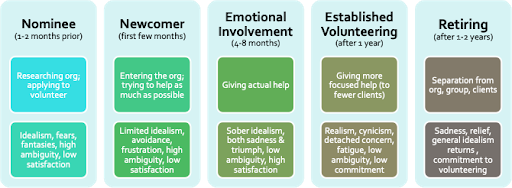
Nominee
This level of engagement is just before someone decides to become a volunteer for an organization. Physically, they are researching your nonprofit and submitting applications. Mentally, nominees feel idealistic, a little apprehensive, and slightly indecisive. There is very little satisfaction at this stage.
Newcomer
The first few months of a volunteer role are considered the Newcomer stage. Often, they are trying to be as helpful as possible, and will have feelings of frustration and ambiguity. Their idealism has come down a notch from when they were a Nominee and their satisfaction levels are still low.
Emotional Involvement
Between months 4 and 8 of service, volunteers experience the most excitement and satisfaction from their position. Now that training is out of the way, they feel (and are) actually helpful. They can fully understand their victories and failures, and experience low ambiguity.
Established Volunteering
After a year of service, volunteers are more realistic about their role and your organization. They may experience cynicism, detached concern, or fatigue. At this time, they are able to give your nonprofit focused, experienced help, but may or may not be committing to doing so due to burnout.
Retiree
As their term of volunteer service comes to a close, volunteers will inevitably separate from your organization. They may feel sad or relieved. But, the idealism they felt before they applied (as well as their commitment to volunteering) usually returns.
Model 3: Volunteers as Community Assets
The final way to look at volunteer program development is from a community organizing perspective. It can go two ways: involvement to create positive change or involvement for awareness.
If your organization has a socially catalyzed agenda to move forward, volunteer involvement in regard to community organizing may be your preferred management style.
Social action – on the part of a community or group – can lead to profound or specific change and can be used as a tactic to make a difference.
Alternately, an organization, might use volunteer (or citizen) involvement as a necessary element to help build the organization’s grassroots strength and power.
Traditional Volunteer Engagement vs. Community Organizing
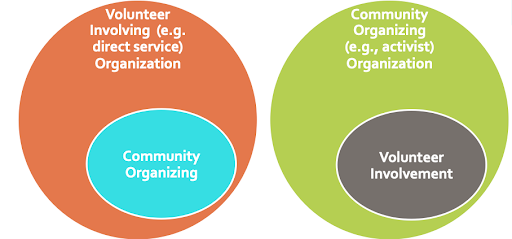
Community organizing is often practiced by those who either traditionally have little power in society – low income people, people of color, or people with disabilities, for example – or by any group that feels its concerns are being ignored.
By working together, members of these groups can exercise power collectively because of their numbers, using the media, their votes, boycotts, and other types of social, political, and economic pressure to convince those in power to rethink their positions.
Direct action organizing is a long game made up of short campaigns. The purpose of the fight is to have a visible win. That way, you can continue to build the strength of the organization and its members.
You Get to Choose
Whether a human resources model or a community organizing model, you get to choose the volunteer program development approach that makes the most sense in any given context.
Choose what makes best sense given your organization’s culture and goals.
Pinpoint What’s Missing from Your Volunteer Program With This Simple Assessment
Download Volunteer Program Checklist
Ever wondered what you might add to make your program even more effective, or what might make executive leadership sit up and take notice?
Well-designed volunteer programs include a good blend of strategic initiatives, solid human resource practices, and capable leadership. Is your program set up for success? Use our checklist to find out!
This checklist will help you assess your program by exploring:
- The core elements of a complete volunteer strategy
- Why they matter
- Where you may want to focus future program development

